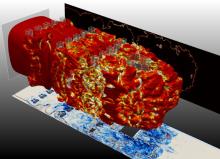Abstract
The AVBP code is a parallel code of fluid mechanics that solves compressible Navier-Stokes equations for laminar and turbulent reactive flows, in 2D and 3D, on unstructured and hybrid meshes, with third order Taylor Galerkin schemes. The resolution of these equations is based on the Large Eddy Simulation (or Large Eddy Simulation) approach. Reduced chemical kinetics according to the Arrhenius law coupled to the TFLES model for sub-grid flame-turbulence interactions make possible to treat combustion phenomena. AVBP can also calculate two-phase flows using a Lagrangian or Eulerian solver. AVBP applies to aeronautical combustion chambers, turbomachinery, industrial furnaces and safety issues, it allows for example to evaluate polluting emissions (CO, NOx and soot), to treat thermo-acoustic instabilities or detonation phenomena. AVBP is a world-famous code in the field of combustion, used by many laboratories (IMFT in Toulouse, EM2C in Centralesupelec, TU Munich, Von Karmann Institute, ETH Zurich, etc.) and in industry (SAFRAN AIRCRAFT ENGINES, SAFRAN HELICOPTER ENGINES, ARIANEGROUP, HERAKLES, TOTAL, etc.).
Objective of the training
The objective of the training is twofold: firstly, to understand the fundamental principles of Large-Scale Simulations for compressive reactive two-phase flows: numerical methods, boundary conditions, LES approach and closure models for LES, combustion as well as two-phase flows through theoretical courses; on the other hand, to learn how to use the AVBP code on the perimeter of two-phase reactive flows through tutorials supervised by experts of the code.
Learning outcomes
At the end of the training, participants will be able to:
• Describe the equations solved in AVBP for computing reactive turbulent two-phase flows.
• Specify the available models to deal with characteristics input and output boundary conditions, wall treatments, chemical kinetics, sub-grid interactions (turbulence and turbulence-flame), two-phase flows.
• Set up the computation of a reactive two-phase turbulent flow in a given geometry, from the generation of the initial solution of and the boundary conditions, through the parametrization of the computation in terms of numerical and physical models, to the launching of the computation on parallel computing machine, and until post-processing of the results.
